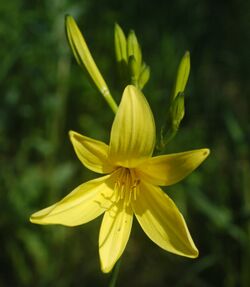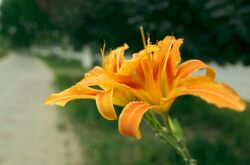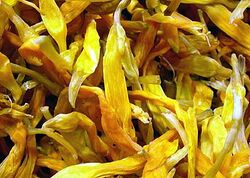Biology:Daylily
| Daylily | |
|---|---|

| |
| Hemerocallis lilioasphodelus | |
| Scientific classification | |
| Kingdom: | Plantae |
| Clade: | Tracheophytes |
| Clade: | Angiosperms |
| Clade: | Monocots |
| Order: | Asparagales |
| Family: | Asphodelaceae |
| Subfamily: | Hemerocallidoideae |
| Genus: | Hemerocallis L. |
| Type species | |
| Hemerocallis lilioasphodelus | |
| Synonyms[1] | |
| |
A daylily or day lily is a flowering plant in the genus Hemerocallis /ˌhɛmɪroʊˈkælɪs/,[2] a member of the family Asphodelaceae, subfamily Hemerocallidoideae, native to Asia. Despite the common name, it is not in fact a lily. Gardening enthusiasts and horticulturists have long bred daylily species for their attractive flowers. Thousands of cultivars have been registered by local and international Hemerocallis societies.[3] Daylilies are perennial plants, whose name alludes to its flowers, which typically last about a day.
Description
Hemerocallis are herbaceous clump-forming perennials growing from rhizomes,[4] some produce spreading stolons. They have a fibrous or fibrous-tuberous root system with contractile roots.[5] The tuberous roots are used to store nutrients and water. The arching leaves are produced from the base of the plant (basal) and lack petioles,[4] they are strap-like, long, linear lanceolate leaves and grouped into opposite fans. The crown is the small portion between the leaves and the roots. The large showy flowers are produced on scapes. The slightly irregular shaped flowers are arranged in helicoid cymes, or produced solitarily.[4] The scapes of some species and cultivars produce small leafy proliferations arising from the nodes or in bracts. The proliferations are clones that root when planted.[6]
Typically Hemerocallis flowers have three similar petals and three sepals, collectively called tepals, and each have a midrib. The centermost part of the flower, called the throat, may be a different color than the more distal areas of the tepals. Each flower has six stamens joined to the perianth tube, each with a two-lobed anther. The unequal stamen filaments are curved upward with the linear-oblong anthers dorsifixed. The superior ovary is green, with three chambers and the stigma is 3-lobed or capitate. The fruit is a capsule (often erroneously called a pod since botanical pods are found in Fabaceae). The fruits may have no seeds (sterile), or many relatively large, shiny, black, roundish seeds.[4][7] The flowers of most species open in early morning and wither during the following night, possibly replaced by another one on the same scape the next day. Some species are night-blooming. The haploid number of chromosomes is eleven.[4]
Taxonomy
Despite their common name, daylilies are not true lilies (plants from the genus Lilium, family Liliaceae). Although the flowers of Hemerocallis and Lilium species have a similar shape, their growth habits, stems and leaf shapes are distinctive. Before 2009, the scientific classification of daylilies put them into the family Liliaceae. In 2009, under the APG III system, daylilies were removed from the family Liliaceae and assigned to the family Xanthorrhoeaceae, subfamily Hemerocallidoideae. Xanthorrhoeaceae was renamed in 2016 to Asphodelaceae in the APG IV system
Species
(As of January 2020), Plants of the World Online recognized 16 species:[8]
- Hemerocallis citrina Baroni (syn. H. altissima Stout, H. coreana Nakai) - China, Japan, Korea, Russian Far East
- Hemerocallis coreana Nakai - Japan, Korea, Shandong Province in China
- Hemerocallis darrowiana S.Y.Hu - Sakhalin Island in Russia
- Hemerocallis dumortieri E.Morren - China, Japan, Korea
- Hemerocallis forrestii Diels - Sichuan + Yunnan Provinces in China
- Hemerocallis fulva (L.) L. (H. sempervirens Araki, H. sendaica Ohwi and H. aurantiaca Baker are now treated as varieties of this species) – orange daylily, tawny daylily, tiger lily, ditch lily - China, Japan, Korea; naturalized in Europe, North America, New Zealand, Indian Subcontinent; considered an invasive weed in some places
- Hemerocallis hakuunensis Nakai (syn. H. micrantha Nakai) - Korea; includes Hemerocallis hongdoensis M.G.Chung & S.S.Kang
- Hemerocallis lilioasphodelus L. (syn. H. flava (L.) L.) – lemon lily, yellow daylily - China, Mongolia, Russian Far East, Siberia, Kazakhstan; naturalized in Europe and North America
- Hemerocallis major (Baker) M.Hotta
- Hemerocallis middendorffii Trautv. & C.A.Mey. - China, Japan, Korea, Russian Far East
- including H. middendorffii var. esculenta (Koidz.) Ohwi, syn. H. esculenta Koidz. – Japan; H. middendorffii var. exaltata, syn. H. exaltata Stout
- Hemerocallis minor Mill. (syn. H. sulphurea Nakai) - China, Mongolia, Korea, Russian Far East, Siberia
- Hemerocallis multiflora Stout - Henan Province in China
- Hemerocallis nana W.W.Sm. & Forrest - Yunnan Province in China
- Hemerocallis plicata Stapf - Sichuan + Yunnan Provinces in China
- Hemerocallis thunbergii Barr (syn. H. serotina Focke, H. vespertina Hara) - Japan
- Hemerocallis yezoensis H.Hara - Japan, Kuril Islands
Two hybrids are recognized:[9]
- Hemerocallis × exilis Satake = H. fulva var. angustifolia × H. thunbergii
- Hemerocallis × fallaxlittoralis Konta & S.Matsumoto = H. littorea × H. thunbergii
A number of hybrid names appear in the horticultural literature but are not recognized as valid by the World Checklist of Selected Plant Families. These include:[9]
- H. × hybrida
- H. × ochroleuca
- H. × stoutiana
- H. × traubara, H. × traubiana
- H. × washingtonia
- H. × yeldara, H. × yeldiana
Etymology
The name Hemerocallis comes from the Greek words ἡμέρα (hēmera) "day" and καλός (kalos) "beautiful".
Distribution and habitat
Hemerocallis species are native to Asia, primarily eastern Asia, including China , Korea, Japan and southern Siberia.[7] This genus is popular worldwide because of the showy flowers and hardiness of many kinds. There are over 80,000 registered cultivars. Hundreds of cultivars have fragrant flowers, and more scented cultivars are appearing more frequently in northern hybridization programs. Some earlier blooming cultivars rebloom later in the season, particularly if their capsules, in which seeds are developing, are removed.[citation needed]
Daylilies have been found growing wild for millennia throughout China, Mongolia, northern India , Korea, and Japan.[10] There are thousand-year-old Chinese paintings showing orange daylilies that are remarkably similar to the flowers that grace modern gardens.
Daylilies may have been first brought to Europe by traders along the silk routes from Asia.[11] However it was not until 1753 that daylilies were given their botanic name of Hemerocallis by the Swedish naturalist Carl Linnaeus.
Daylilies were first brought to North America by early European immigrants, who packed the roots along with other treasured possessions for the journey to the New World. By the early 1800s, the plant had become naturalized, and a bright orange clump of flowers was a common sight in many homestead gardens.
The orange or tawny daylily (Hemerocallis fulva), common along roadsides in much of North America, is native to Asia. Along with the lemon lily (Hemerocallis flava), it is the foundational species for most modern cultivars.
Cultivation
As popular as daylilies were for many hundreds of years, it was not until the late 19th century that botanists and gardeners began to experiment with hybridizing the plants. Over the next hundred years, thousands of different hybrids were developed from only a few wild varieties. In fact, most modern hybrids are descended from two types of daylily. One is Hemerocallis flava—the yellow lemon lily. The other is Hemerocallis fulva, the familiar tawny-orange daylily, also known affectionately as the "ditch lily".[12]
The daylily has been nicknamed "the perfect perennial" by gardeners, due to its brilliant colors, ability to tolerate drought and frost and to thrive in many different climate zones, and for being generally low maintenance. It is a vigorous perennial that lasts for many years in a garden, with very little care and adapts to many different soil and light conditions.[13] Daylilies have a relatively short blooming period, depending on the type. Some will bloom in early spring while others wait until the summer or even autumn. Most daylily plants bloom for 1 through 5 weeks, although some bloom twice in one season ("rebloomers)".[14] Daylilies are not commonly used as cut flowers for formal flower arranging, yet they make good cut flowers otherwise, as new flowers continue to open on cut stems over several days.[citation needed]
Cultivars
There are more than 35,000 daylily cultivars.[13] Depending on the species and cultivar, daylilies grow in USDA plant hardiness zones 1 through 11, making them some of the more adaptable landscape plants. Hybridizers have developed the vast majority of cultivars within the last 100 years. The large-flowered, bright yellow Hemerocallis 'Hyperion', introduced in the 1920s, heralded a return to gardens of the once-dismissed daylily, and is still widely available in the nursery trade. Daylily breeding has been a specialty in the United States, where daylily heat- and drought-resistance made them garden standbys since the 1950s. New cultivars have sold for thousands of dollars,[citation needed] but many sturdy and prolific cultivars sell at reasonable prices of US$20 or less.
Hemerocallis is one of the very highly hybridized plant genera. Hybridizers register hundreds of new cultivars yearly. Hybridizers have extended the genus' color range from the yellow, orange, and pale pink of the species, through vibrant reds, purples, lavenders, greenish tones, near-black, near-white, and more. However, hybridizers have not yet been able to produce a daylily with primarily blue flowers. Flowers of some cultivars have small areas of cobalt blue.
Other flower traits that hybridizers developed include height, scent, ruffled edges, contrasting "eyes" in the center of a bloom, and an illusion of glitter called "diamond dust". Sought-after improvements include foliage color, variegation, plant disease resistance, and the ability to form large, neat clumps. Hybridizers also seek to make cultivars cold-hardier by crossing evergreen and semi-evergreen plants with dormant varieties.
In recent decades, many hybridizers have focused on breeding tetraploid plants, which tend to have sturdier scapes and tepals than diploids, as well as some flower-color traits that are not found in diploids. Until this trend took root, nearly all daylilies were diploid. "Tets," as they are called by aficionados, have 44 chromosomes, while triploids have 33 chromosomes and diploids have 22 chromosomes per individual plant. Diploid and tetraploid daylilies cannot be crossed to produce new cultivars[15] Hemerocallis fulva 'Europa', H. fulva 'Kwanso', H. fulva 'Kwanso Variegata', H. fulva 'Kwanso Kaempfer', H. fulva var. maculata, H. fulva var. angustifolia, and H. fulva 'Flore Pleno' are all triploids that almost never produce seeds and reproduce almost solely by underground runners (stolons) and dividing groups by gardeners. A polymerous daylily flower is one with more than three sepals and more than three petals. Although some people[who?] synonymize "polymerous" with "double", some polymerous flowers have as many as twice the normal number of sepals and petals.
Formerly daylilies were only available in yellow, pink, fulvous (bronzed), and rosy-fulvous colors, now they come in an assortment of many more color shades and tints thanks to intensive hybridization. They can now be found in nearly every color except pure blue and pure white. Those with yellow, pink, and other pastel flowers may require full sun to bring out all of their colors; darker varieties, including many of those with red and purple flowers are not colorfast in bright sun.
H. 'Kwanzo' – a triple-flowered triploid cultivar
Awards
The highest award a cultivar can receive in the United States is the Stout Silver Medal, given in memory of Dr. Arlow Burdette Stout, who is considered to be the father of modern daylily breeding in North America. This annual award—as voted by American Hemerocallis Society Garden judges—can be given only to a cultivar that has first received the Award of Merit not less than two years previously. The 2014 winner of the Stout Silver Medal is 'Webster's Pink Wonder', hybridized by Richard Webster and introduced by R. Cobb. A complete list of Stout Silver Medal winners can be seen on the AHS website.[16]
In the UK the following cultivars have gained the Royal Horticultural Society's Award of Garden Merit:-[17]
- 'All American Chief'
- 'Always Afternoon'
- 'Arctic Snow'
- 'Asterisk'
- 'August Frost'
- 'Beauty to Behold'
- 'Burning Daylight'[18]
- 'Cat Dancer'
- 'Cayenne'
- 'Cherry Eyed Pumpkin'
- H. citrina
- 'Condilla'
- 'Curly Cinnamon Windmill'
- 'Custard Candy'
- 'Eggplant Escapade'
- 'Elegant Candy'
- 'Fooled Me'
- 'Grey Witch'
- 'Holly Dancer'
- 'Jamaican Me Crazy'
- 'Jellyfish Jealousy'
- 'Julie Newmar'
- 'Karen's Curls'
- 'Killer'
- 'Lady Neva'
- 'Lime Frost'
- 'Mahogany Magic'
- 'Mary's Gold'
- 'Moonlit Masquerade'
- 'North Wind Dancer'
- 'Old Tangiers'
- 'Performance Anxiety'
- ‘Pink Damask’[19]
- 'Primal Scream'
- 'Radiant Moonbeam'
- ’Red Precious’[20]
- 'Ruby Spider'[21]
- 'Running Late'
- 'Russian Rhapsody'
- 'Selma Longlegs'
- 'Serena Sunburst'[22]
- 'Sir Modred'[23]
- 'Spider Man'
- 'Stafford'[24]
- 'Strawberry Candy'
- 'Tuxedo Junction'[25]
Pests and diseases
Contarinia quinquenotata, commonly known as the daylily gall midge, is a small gray insect infesting the flower buds of Hemerocallis species causing the flower to remain closed and rot.[26] It is a pest within the horticultural trade in several parts of the world, including Southern and Eastern Europe, the United Kingdom, Canada, and the United States.[27]
Toxicity
Eating too many uncooked flowers of some species can cause diarrhea.[28] Hemerocallis species are toxic to cats and ingestion may be fatal. Treatment is usually successful if started before kidney failure has developed.[29]
Uses
Daylilies are an economically important group of plants used medicinally, as food, and as horticultural plants. They have been cultivated in East Asia starting in China for thousands of years.[4] Hemerocallin, a root neurotoxin, has been used as poison and therapeutically as part of traditional oriental medicine.[4] Some flowers of certain species such as Hemerocallis citrina are used in Chinese cuisine.[30] They are sold fresh or dried in Asian markets as gum jum (金针 in Chinese; pinyin: jīn zhēn) or yellow flower vegetables (黃花菜 in Chinese; pinyin: huáng huā cài). These are used in hot and sour soup, daylily soup (金針花湯), Buddha's delight, and moo shu pork. The tubers and young leaves of H. fulva can be eaten raw or cooked. The flowers are more palatable upon cooking. [28]
Moreover, Daylilies are among the most popular North American garden plants. Registered cultivars of Hemerocallis now exceed 38,000, including more than 13,000 named clones of H. fulva (G. Grosvenor 1999; R. M. Kitchingman 1985; R. W. Munson Jr. 1989; W. B. Zomlefer 1998).
See also
- Arlow Stout – pioneer in the hybridization of daylilies
- Contarinia quinquenotata – daylily gall midge
- Hemerocallis 'Duke of Durham'
- Siloam daylilies – over 450 daylily cultivars registered by Pauline Henry.
- List of plants known as lily
References
- ↑ "Hemerocallis". World Checklist of Selected Plant Families (WCSP). Royal Botanic Gardens, Kew. http://wcsp.science.kew.org/namedetail.do?name_id=277620.
- ↑ Sunset Western Garden Book, 1995:606–607
- ↑ "International Daylily Groups". American Hemerocallis Society. http://www.daylilies.org/ingroups.html.
- ↑ Jump up to: 4.0 4.1 4.2 4.3 4.4 4.5 4.6 "Hemerocallis in Flora of North America @ efloras.org". http://www.efloras.org/florataxon.aspx?flora_id=1&taxon_id=114981.
- ↑ Bajaj, Y. P. S. (2012-12-06) (in en). Plant Protoplasts and Genetic Engineering VI. Springer Science & Business Media. ISBN 978-3-642-57840-3. https://books.google.com/books?id=jGrpCAAAQBAJ&pg=PA70.
- ↑ Wyman, Donald (1986) (in en). Wyman's Gardening Encyclopedia. Simon and Schuster. ISBN 978-0-02-632070-2. https://books.google.com/books?id=XSExQDJtQ7AC&pg=PA519.
- ↑ Jump up to: 7.0 7.1 T︠S︡velëv, Nikolaĭ Nikolaevich (2001-06-01) (in en). Flora of Russia -. CRC Press. ISBN 978-90-5410-754-5. https://books.google.com/books?id=vmW-DPOAttEC&pg=PA313.
- ↑ "Hemerocallis L.". Plants of the World Online. Royal Botanic Gardens, Kew. https://powo.science.kew.org/taxon/urn:lsid:ipni.org:names:24324-1.
- ↑ Jump up to: 9.0 9.1 World Checklist of Selected Plant Families, The Board of Trustees of the Royal Botanic Gardens, Kew, http://apps.kew.org/wcsp/namedetail.do?name_id=277620, retrieved July 19, 2014
- ↑ Leatherbarrow, Liesbeth (1999). 101 Best Plants for the Prairies. Madison, Wisconsin: Fifth House Publishers. ISBN 978-1894004305. https://archive.org/details/101bestplantsfor0000leat.
- ↑ Halpin, Anne Moyer (1992). The Naming of Flowers. Stamford, Connecticut: Longmeadow Press. ISBN 978-0681416543.
- ↑ Cassidy, Frederic Gomes (2002). Dictionary of American Regional English. Cambridge, Massachusetts: Harvard University Press. ISBN 978-0681416543.
- ↑ Jump up to: 13.0 13.1 "Growing daylilies". http://www.extension.umn.edu/garden/yard-garden/flowers/growing-daylilies/.
- ↑ "Dayliles Frequently Asked Questions". American Hemerocallis Society. American Hemerocallis Society, Inc. http://www.daylilies.org/AHSFAQsNew.html#time.
- ↑ Daylilies undated info page at University of Nebraska. Accessed August 1, 2007.
- ↑ "AHS Awards and Honors: Stout Medal Winners". May 2018. http://www.daylilies.org/stoutmedal.html.
- ↑ "AGM Plants - Ornamental". Royal Horticultural Society. July 2017. p. 47. https://www.rhs.org.uk/plants/pdfs/agm-lists/agm-ornamentals.pdf.
- ↑ "RHS Plantfinder - Hemerocallis 'Burning Daylight'". https://www.rhs.org.uk/Plants/76072/i-Hemerocallis-i-Burning-Daylight/Details.
- ↑ "RHS Plantfinder - Hemerocallis 'Pink Damask'". https://www.rhs.org.uk/Plants/89831/i-Hemerocallis-i-Pink-Damask/Details.
- ↑ "RHS Plantfinder - Hemerocallis 'Red Precious'". https://www.rhs.org.uk/Plants/98037/i-Hemerocallis-i-Red-Precious/Details.
- ↑ "RHS Plantfinder - Hemerocallis 'Ruby Spider'". https://www.rhs.org.uk/Plants/181143/i-Hemerocallis-i-Ruby-Spider/Details.
- ↑ "RHS Plantfinder - Hemerocallis 'Serena Sunburst'". https://www.rhs.org.uk/Plants/47592/i-Hemerocallis-i-Serena-Sunburst/Details.
- ↑ "RHS Plantfinder - Hemerocallis 'Sir Modred'". https://www.rhs.org.uk/Plants/170533/i-Hemerocallis-i-Sir-Modred/Details.
- ↑ "RHS Plantfinder - Hemerocallis 'Stafford'". https://www.rhs.org.uk/Plants/99494/i-Hemerocallis-i-Stafford/Details.
- ↑ "Hemerocallis 'Tuxedo Junction'". RHS. https://www.rhs.org.uk/Plants/328115/Hemerocallis-Tuxedo-Junction/Details.
- ↑ "Hemerocallis Gall Midge". American Hemerocallis Society. http://www.daylilies.org/ahs_dictionary/gallmidge.html.
- ↑ "Continaria quinquenotata". Phytosanitary Alert System. North American Plant Protection Organization. 2014. http://www.pestalert.org/viewArchPestAlert.cfm?rid=68.
- ↑ Jump up to: 28.0 28.1 (in en-US) The Complete Guide to Edible Wild Plants. United States Department of the Army. New York: Skyhorse Publishing. 2009. pp. 51. ISBN 978-1-60239-692-0. OCLC 277203364. https://www.worldcat.org/oclc/277203364.
- ↑ Fitzgerald, K.T. (2010). "Lily toxicity in the cat". Topics in Companion Animal Medicine 25 (4): 213–217. doi:10.1053/j.tcam.2010.09.006. PMID 21147474.
- ↑ "Hemerocallis citrina". http://frps.eflora.cn/frps/Hemerocallis%20citrina.
External links
| Wikimedia Commons has media related to Hemerocallis. |
- "Daylily", Tropicos, Missouri Botanical Garden, http://www.tropicos.org/NameSearch.aspx?projectid=&name=Daylily
- Hemerocallis species by the Drs. Plodeck has species, hybrids, and cultivars; links; terms and Latin meanings; images and history of hybrids
- Charlotte's Daylily Diary Charlotte Chamitoff's Daylily Diary is a wealth of information on growing daylilies and daylily hybridizing. The website is full of daylily images and information about individual hybridizers.
- Charlotte's International Garden of the Week For more than a decade, Charlotte Chamitoff has delighted daylily lovers with her Garden of the Week. See daylily gardens from all over the world.
Daylily societies
- The American Hemerocallis Society
- Australian Daylily Society
- Canadian Hemerocallis Society
- National Capital Daylily Club
- Northern Virginia Daylily Society
- Ontario Daylily Society
- Region 4 of the American Hemerocallis Society
- The British Hosta and Hemerocallis Society
- The Metropolitan Columbus Daylily Society
Wikidata ☰ Q156275 entry
 |












